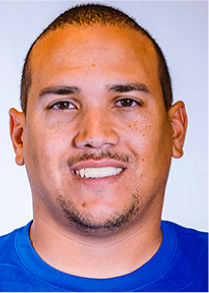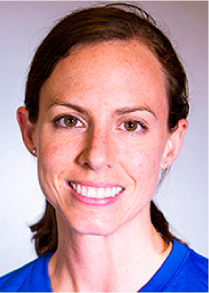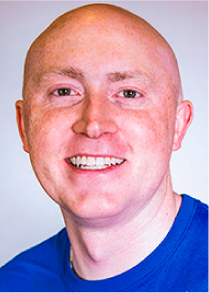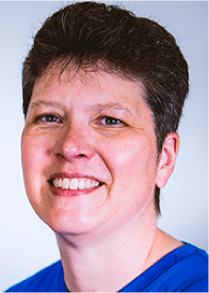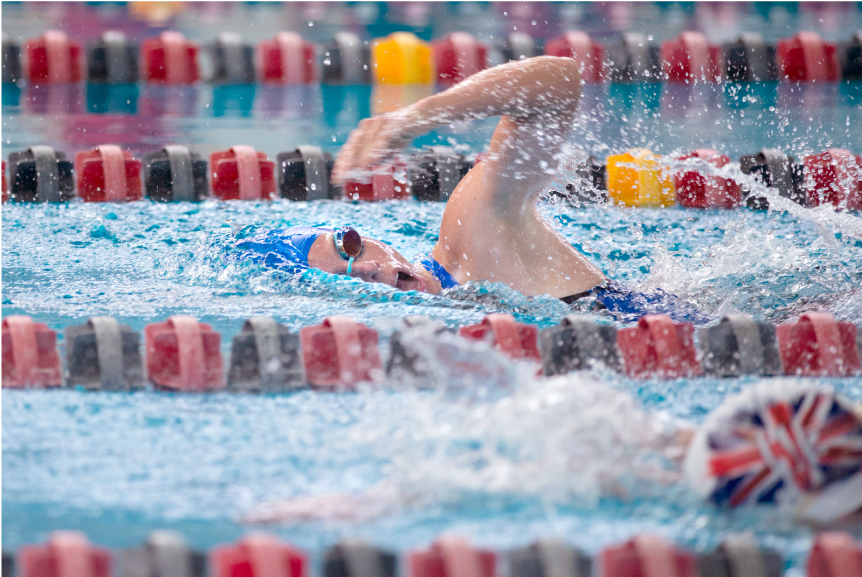
MSgt. Linn Knight competes in swimming during the 2017 DOD Warrior Games at the University of Illinois at Chicago July 8. DOD photo by Roger L. Wollenberg.
Gold, silver, and bronze medals were handed out at the 2017 DOD Warrior Games in Chicago, but the more important prizes were a sense of fellowship and achievement among the participants—and a broader feeling of community as they pursue their recovery.
Whether cheering on the sidelines or pushing a teammate across the finish line, the spirit and resiliency of some 265 wounded, ill, or injured service members was on proud display at the games, which took place June 30 to July 8.
Athletes from the US Air Force, Army, Navy, Marine Corps, Coast Guard, the United Kingdom’s armed forces, and Australian Defense Force competed for medals in eight events: archery, cycling, field, shooting, sitting volleyball, swimming, track, and wheelchair basketball.
“It’s been absolutely fantastic to see the camaraderie in all the services. It goes straight to your heart,” said Brig. Gen. Kathleen A. Cook, director of Air Force Services. “We’re seeing athletes … pick up something new for the first time, and that’s the beauty of what these adaptive sports can do” for them. She said the games are designed to help the participants recognize and focus on the capabilities they have, rather than those they don’t.
“The beauty of this program is to get them through their recovery and rehabilitation so that they can thrive in their new normal,” Cook said.
The Paralympic-style event was created in 2010. It was overseen by the US Olympic Committee until the Defense Department took it over in 2015 to better align the games with service members’ recovery processes.
Each military service takes turns hosting the games. The 2017 Navy-sponsored games in Chicago were the first to be held outside a military installation. The Air Force will host the 2018 games at the US Air Force Academy in Colorado Springs, Colo.
Athletes suffer from a range of afflictions, including upper- or lower-body injury, spinal cord injury, traumatic brain injury, visual impairment, serious illnesses, and/or post-traumatic stress. While their individual symptoms vary widely, often their challenges are similar, and by sharing their stories and pushing themselves physically, mentally, and spiritually, they inspire each other and those around them to never give up and to keep fighting.
Here are the stories of four members of the Air Force team:
MSgt. Brian Williams
Then-SSgt. Brian Williams was on his sixth deployment—the second to Afghanistan—when the explosion happened. It was April 25, 2012, and the military working dog handler was attached to an Army unit in Helmand province that was tasked with clearing a known Taliban compound.
Williams swept the stairs of the compound before sending his German shepherd, Carly, upstairs. Everything was clear, but Carly didn’t come back out. Williams called for the dog but he still didn’t come, so he went inside to get him. As he was going up the stairs, an improvised explosive device (IED)went off.
“I don’t feel like I was ever knocked out, but when I landed, my leg was already torn below the knee, I had a compound fracture in my left wrist, soft tissue damage, missing teeth, TBI [traumatic brain injury]. You name it,” said Williams.
Carly was not injured in the blast, and Williams never did find out what was keeping the dog inside. He was medically evacuated and sent back to the States within a week, where he would spend a year-and-a-half recovering at Walter Reed National Military Medical Center in Bethesda, Md.
Doctors amputated Williams’ leg above the knee to prevent infections and later told him that his left hand likely would have been blown off if it weren’t for a $20 Casio watch he purchased right before deployment so he would always know what time it was back home.
While at Walter Reed, Williams underwent more than 15 surgeries and endured more than 500 hours of rehabilitation therapy, but he tried not to reflect on “how horrible it could have been, or was,” he said. “I see other people who had it worse than me. Some people lost two [limbs], some people lost three, some people lost four. I was just thankful, and it was humbling to be around those individuals because they seemed to be very spirited, almost happy.”
Despite all the support he received from his then-girlfriend—now wife—family members, and others at Walter Reed, Williams said he still felt a “void” because there wasn’t “a lot of Air Force love” at the hospital. His friend, MSgt. Benjamin G. Seekell, a fellow military working dog handler who’s also on the Air Force’s Warrior Games team, had been wounded about a year before Williams,when he and his dog, Charlie, stepped on a land mine in Bagram, Afghanistan. Seekell also had his left leg amputated below the knee and was able to help Williams through his recovery.
“Part of the reason why I didn’t freak out is because he [Seekell] had already returned to duty, so I knew it was possible to do if I kept my mind right,” said Williams.
But it wasn’t until he became involved in the Air Force Wounded Warrior (AFW2) Program that Williams really started to connect with other airmen he could relate to. The Air Force reached out to get him involved while he was going through the medical board process, but Williams’ first priority was getting back to work.
On Oct. 28, 2013—a year-and-a-half after the explosion—Williams returned to work at JB McGuire-Dix-Lakehurst, N.J., but it would still be a long time before he was officially cleared for duty. Though he acquired a running leg, it is difficult for Williams to run because his bone density is too low from the explosion. That and his TBI made the Air Force question whether he was fit for duty. He went before a medical evaluation board, which initially recommended he medically retire. He appealed, but lost again. Finally, the decision went all the way to then-Air Force Secretary Deborah Lee James who in February 2015 gave Williams the green light to continue serving in the Air Force.
Williams was thrilled to see his Air Force career back on track, but he still felt a little “isolated.” That’s when he got involved with AFW2.
“There are so many different people, different stories, different injuries and sicknesses,” said Williams. “It was nice to be around those people at that point in time. I hadn’t had that yet.”
He arrived at JBSA-Lackland, Texas, for a four-year tour as a security forces instructor in 2015. That same year, he competed in his first Warrior Games. In 2016, he had an opportunity to give back to the Air Force for giving him another chance. During the sitting volleyball gold medal award ceremony at West Point, James handed Williams his gold medal and was surprised when he handed it back to her.
“I was on a natural high and I just wanted to extend the same thing to her because I don’t know if she’s ever going to get a gold medal,” Williams told ESPN. “So here. Here’s mine. Take it. She was taken aback at first. She said, ‘Are you sure?’ I said, ‘I’m serious. I’ve won golds before and I know how it makes me feel.’?”
Williams has competed in three Warrior Games and one Invictus Games—another international Paralympic-style games—and he planned to compete at the next Invictus Games in Toronto in September.
“I will keep going until they tell me otherwise,” said Williams.
MSgt. Linn A. Knight
MSgt. Linn A. Knight’s vehicle blew up on the first mission of her first deployment to Afghanistan in 2010. The explosive ordnance disposal (EOD) technician was embedded with US marines in Marjah when her Humvee rolled over an IED.
Fortunately, the vehicle’s armor shielded her from the full impact of the blast and Knight escaped relatively unscathed. She continued on with her deployment, but the team was to take worse.
On their last mission together, Knight’s convoy hit another IED and two of her closest friends—Cpl. Justin Gaertner and Sgt. Gabriel Martinez—were badly wounded.
“Gabe was on the side of the road. He was screaming bloody murder. I was on the other side with Justin. I put tourniquets on his arm and leg … and his intestines were coming out of his body,” said Knight.
Her mission commander, who was outside the most intense blast zone when the other two marines lost their legs, was still seriously wounded. He ended up taking a medical retirement from the Marine Corps after several vertebrae had to be removed from his neck.
All three marines lived, but the sound of their screams and the images from that day would torment Knight for years.
“Gabe was my favorite guy on the convoy and then he got blown up. He haunted me for quite a while. I would see him out running with me even though he had no legs,” said Knight.
After the casualty report was filed, the Air Force tried to get Knight involved in the Wounded Warrior Program, but she wasn’t ready. “I was just … avoiding my issues,” she said.
Instead, she threw herself into work and tried to ignore the relentless memories.
In 2013, while deployed to South Korea, Knight was diagnosed with Stage Three breast cancer. The Air Force brought her back to the “patients squadron” at JB San Antonio, Texas, and once again pushed her to get involved in the Wounded Warrior Program.
Sick and tired from chemotherapy, Knight grudgingly attended her first camp in 2015 and it changed her life. The other participants’ support and passion quickly won her over and the judgment-free zone allowed her to finally address her invisible wounds.
At one camp, Knight took a music class, though she’s not necessarily musically inclined. She and the others sat in a circle and listened to Fleetwood Mac, changing the lyrics to match their mood. During another session, she tried painting. Each brush stroke helped free the pain she’d been hiding.
“They treat your body, your mind, [and] your spirit,” Knight said. “This may sound really weird, but I’m kind of thankful I got breast cancer because that’s probably the only way I would slow down and take care of me.” She said it was “really hard to throttle back, and when you finally do slow down, you have to think about what’s going on in your head and who you are. You know, you’re not just the mission.”
Knight was still “struggling” in her mind, but continued to put on a happy face for her peers. That is, until she got to the forum at the camp.
EOD, she said, is “a macho career field, so you’ll probably get more jokes than anything, but a lot of that … hides the pain. … It may take a minute, but people do open up. You see a side of people that maybe you don’t see in the sports. You see them being a strong warrior, but in that session you see why they have to be so strong. It’s because they went through some shit.”
“It’s cathartic to tell your own story,” she explained, “and for other people who may have gone through similar things, it’s therapeutic to hear it and know that you’re not alone.”
Knight had always been in good shape—it was a necessity in her career field. She was used to running 5Ks in her heavy bomb disposal suit, but the chemotherapy made her feel like she was “melting into the couch.” The fatigue was overwhelming. The chemo also affected her heart and her blood’s ability to carry oxygen. It took everything she had to make it two laps around the track the first time she ran after completing radiation.
“Coming to the camps showed me that I could push myself,” said Knight.
The word “can’t” wasn’t in the coaches’ vocabularies. If a participant was struggling, they just showed them a different way to accomplish the task. It was exactly what Knight needed to get her fitness level back.
Now four years into remission, Knight is just a year away from being declared “healed,” and her work ethic is as strong as ever. Leading up to her first Warrior Games in Chicago, Knight immersed herself in a rigorous training regimen. Not only did she conduct regular unit training five days a week and squadron PT two days a week, she strived to get in three track sessions, three bike rides, and three swims each week. She was routinely training two to three times a day, in addition to her full time Air Force requirements.
Her hard work paid off. She won 10 medals at the games, including four swimming golds in the 50 freestyle, 100 freestyle, 50 backstroke, and 4×50 relay; four silvers in the 100-meter sprint, 200-meter sprint, 400-meter sprint, and 50-meter breaststroke; and two bronze medals in the 4×100 sprint relay and in cycling.
Austin Williamson
Retired Capt. Austin Williamson had a choice to make. He could compile a bucket list and “start checking things off,” or he could “live life in spite of the disease.” He chose the latter.
In April 2015, Williamson, 27, was diagnosed with Stage Four Synovial Cell Sarcoma—an advanced cancer that affects soft tissues in the body. The “primary tumor” started on the bottom of his right foot and then grew up through his ankle. His doctors conducted a biopsy of lymph nodes in his groin and behind his right knee, and though the results were clear, a full-body scan revealed multiple tumors in his lungs. To prevent the cancer from spreading even further, Williamson’s right leg was amputated below the knee and he started chemotherapy a few months later.
At the time, he was a first lieutenant and was working as a developmental engineer at Tinker AFB, Okla.
“I got promoted on June 6 and my amputation was June 4, so I always joke that my promotion cost me an arm and a leg and I got it for half price,” Williamson told Air Force Magazine shortly after he finished his upright cycling race in Chicago. It’s a “well-used joke among amputees,” he admitted. “I’ve stolen that many times.”
Despite his positive attitude, Williamson has struggled with his illness. Even though the biopsy of his groin was clear, it took time for the wound to close because of complications from the surgery.
“I felt like I was a magic trick,” said Williamson, smiling. “They had to pack … four or five feet of gauze into [the wound] and they would pull it out and pack it again. I felt like one of those magicians that had the ribbon coming out of their sleeve, but it was coming out of my leg.”
He relied heavily on his wife, early on. “I was just getting used to dealing with not having a limb and being too tired to get up and get a leg or get on my crutches,” he said. “We went from sharing a lot of the roles at home to her having to take on a lot more than I would like.”
It was around this time that Williamson and his wife attended their first camp for wounded warriors at Eglin AFB, Fla. Dubbed “care events,” the camps are much more than just sports. Williamson spent some time talking about employment outside of the Air Force (he would eventually take a medical retirement), and his wife was introduced to the resources available for caregivers. The games and the Air Force Wounded Warrior Program put her in touch with other caregivers, many of whom have become close friends.
“They are able to support each other when they see us struggling, and of course, they struggle, too,” said Williamson. “They have times when they get scared or upset with the process and everything that goes on through dealing with disease or injury, with transitioning out of the military, dealing with how to get those benefits,” all “on top of taking care of us. It’s a lot. So they definitely need a break and an outlet to get some support, and they get it here.”
After the Eglin camp, Williamson had to be fitted for a new prosthetic because the volume of his limb changed. It’s a painful process—one that’s challenging both physically and mentally—but Williamson pushed through. Being around other wounded warriors helped.
Two years after he was diagnosed, Williamson is still undergoing chemotherapy. The tumors in his lungs are still there, but they are now slightly smaller. He completed his 22nd round of chemo about two-and-a-half weeks before he started the games in Chicago, where he competed in every event.
“Leading up to this, it wasn’t great training. I had a cough I couldn’t get rid of and I was really just focusing on trying to stay healthy, as healthy as I could, to be ready for this,” said Williamson.
He earned a silver medal in the ultimate championship competition and said it made the “tough week … worth it.”
“When we have a bad day, we pick each other up and cheer each other on,” said Williamson. “That camaraderie between the branches is a big deal and that’s what the Warrior Games are all about.” That esprit de corps was “one of the big reasons why I wanted to be here and be a part of it.”
Maj. Teresa Sellers
Maj. Teresa Sellers never thought of herself as an athlete. She still doesn’t, even though she competes in triathlons and won three gold medals at this year’s Warrior Games.
Sellers is a planner and has always loved a challenge. She enlisted in the Air Force in 1992 as a medical laboratory journeyman, earned her master’s degree in nursing science, and received her commission in 2003. After deploying to Afghanistan in 2014, Sellers said she had the next 40 years of her life “all planned out.” But she got “a little sidetracked” when she was diagnosed with cervical and endometrial cancer just a few months after returning home.
An Active Duty surgical operations nurse at JB Elmendorf-Richardson, Alaska, Sellers went through five months of chemotherapy and was feeling “pretty discouraged with my cancer” and the toll it took on her body. Because of the chemotherapy, she will always suffer from lymphedema, a chronic condition that prevents her body from properly draining fluid, and it causes her leg to swell. She also has neuropathies in her feet, which sometimes makes them feel like they are on fire.
“I carry a lot more weight in this leg. The chemo destroyed the nerves in my feet. Those are things that will never go away,” said Sellers. “You just learn how to deal with it.”
That’s when her recovery care coordinator encouraged her to get involved in the Air Force Wounded Warrior Program. Like many others, Sellers initially resisted. She dismissed the program as designed “for people who are missing a limb or something like that.” Eventually, Sellers relented and the experience has “been awesome,” she said.
She attended her first camp, an equestrian camp, in Colorado Springs in 2015. Then she went to another in San Antonio in 2016 and yet another at JB Lewis-McChord, Wash.
“From there, the coaches were like, ‘You’re an athlete. You can do this stuff.’?” They were right. Sellers won a gold medal in the air rifle prone competition, gold in the air rifle standing competition, and gold in the 200-meter freestyle swimming relay. She also finished in sixth place in upright cycling.
The camaraderie and support she’s received from the coaches and other athletes have really helped in her recovery. Sellers said it’s encouraging to see people “who have more disability than I do,” go from thinking, “I can’t, I can’t, I can’t” to realizing, actually, “they can.”
“There are a lot of people out here that have way more issues than I do. You just deal with it. You move on. You don’t let that stop you. … If they can do it, by George, I can, too. If they can overcome it, so can I,” said Sellers.
The Warrior Games have motivated Sellers to push past the “side effects of chemo” and “keep going, and keep setting goals, and get my health back.”
But the best thing about the games, she said, is “the family that you just inherited.”
